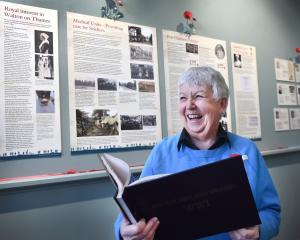Dunedin's largest construction boom in decades is about to begin, with the University of Otago revealing plans to spend $650 million upgrading its campuses.
The university for the first time yesterday released the schedule and total cost of its massive 15-year ''priority development plan'', which involves more than 20 projects and is expected to create ''hundreds'' of jobs for Dunedin.
The plan includes a project to demolish the university's six-storey 1969-built arts building and its property services building, both in Albany St, and develop a ''humanities precinct'' in their place.
A ''teaching, learning and research'' space is to be built in Portobello to replace the university's old aquarium building, which has been closed since 2012 after it was found to be quake-prone.
The plan was for the space, scheduled to be completed at the start of 2016, to serve as a ''medium-term'' solution ahead of building a completely new aquarium, probably in the harbour basin area. A new music facility, including a centre of performing arts, is also planned for near the existing music studio in Albany St.

It's a major positive for the construction industry in the Dunedin area and it's certainly going to create jobs and create optimism.''
'A lot of local industries, particularly people like electricians, plumbers and mechanical services people, should be given a bit of confidence to be taking on apprentices and training people,'' Mr Herd said.
That the building programme was spread over about 15 years was also ''very helpful'', as recent projects such as Forsyth Barr Stadium had been ''one-offs''.
Otago University chief operating officer John Patrick yesterday told staff about the university's plans, which were later released to the Otago Daily Times.
Its ''priority projects'' were ranked, with the replacement of its ageing dental school - previously estimated to cost between $50 million and $100 million - taking top spot.
Construction was planned to start on the dental school in the third quarter of next year and finish at the end of 2019.
The ''significant redevelopment'' of the university's science precinct, including the construction of new teaching and research laboratories, took second spot, with new research project facilities third on the list.
A new ''biomedical research'' building was also planned, concentrating research now spread throughout the Dunedin campus into one development in the south of the campus.
The programme includes the continuation of the university's seismic strengthening work and major maintenance projects, such as refurbishment of buildings in the historic precinct, including the clocktower building.
Outside Dunedin it planned to complete the refurbishment and seismic strengthening of its Wellington (UOW) facilities and build a ''major new facility'' in the new Christchurch (UOC) health precinct. Vice-chancellor Prof Harlene Hayne said the plan was about improving the campus environment for both staff and students.
''We want to improve what is already a first-class experience for students, for teachers and for researchers, and we want the campus to be enjoyed by the communities in which we live,'' Prof Hayne said.
The university council had agreed to the priority development plan ''in principle'', but the plan was a living document and projects could yet be added, or removed, as situations and needs change.
Mr Patrick said the university intended not to resort to ''large-scale'' borrowing to fund the programme.
''Currently, the university does not use debt to fund capital projects, but looking ahead, may want to do this,'' Mr Patrick said. The university needed to invest in its facilities to be successful and without the investment its position as a top institution would be put at risk.
''[Without investment] it is likely the university would see a drop in research and teaching quality as it would be difficult to attract the best staff and the brightest students.''
The two major risks of the plan were controlling costs and ensuring it generated enough funding ''to pay for it all''.
''We are aware of the risks and the options we have to mitigate them.''
Mr Patrick was excited to see the plan come to fruition.
''Any new developments that improve the quality of this fantastic university and its beautiful campus are exciting for me and a source of pride.''
Dunedin Mayor Dave Cull said the programme underscored that tertiary education was the ''most important'' industry in the city.
The city was lucky to have such a well-run institution, but could not take the university for granted.
''We have got to ... maintain the city's attractiveness to the kind of people we want to be studying or teaching at our university.''
''We have got to look across the board at the standard of our housing, the cycleway infrastructure and all the recreational and cultural offerings of the city.''
Mr Cull, who is a member of the university council, said an ''enormous amount of research and planning'' had gone into the university's plan.
Tertiary Education Minister Steven Joyce, who was visiting Dunedin yesterday, hailed the programme as a ''comprehensive plan'' which would take the university to the ''next level''.
The plan was in part possible because the Government had continued to increase funding for the university in what had been tough economic times, he said.











!["[The sector is] less competitive than groceries and banks that the government spend a lot of...](https://www.odt.co.nz/sites/default/files/styles/odt_landscape_small_related_stories/public/story/2025/04/billie_moore.jpg?itok=GN8uIA4p)
